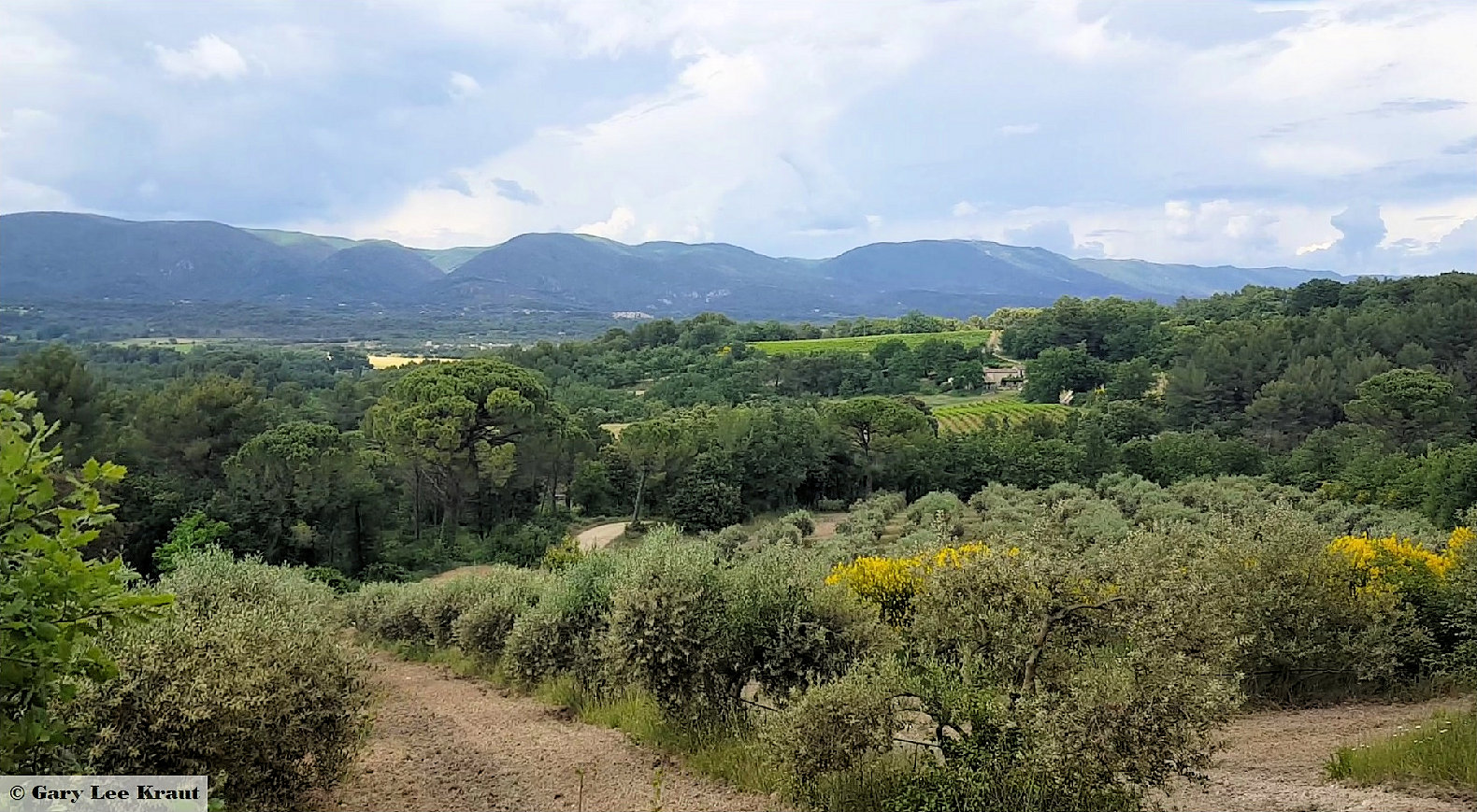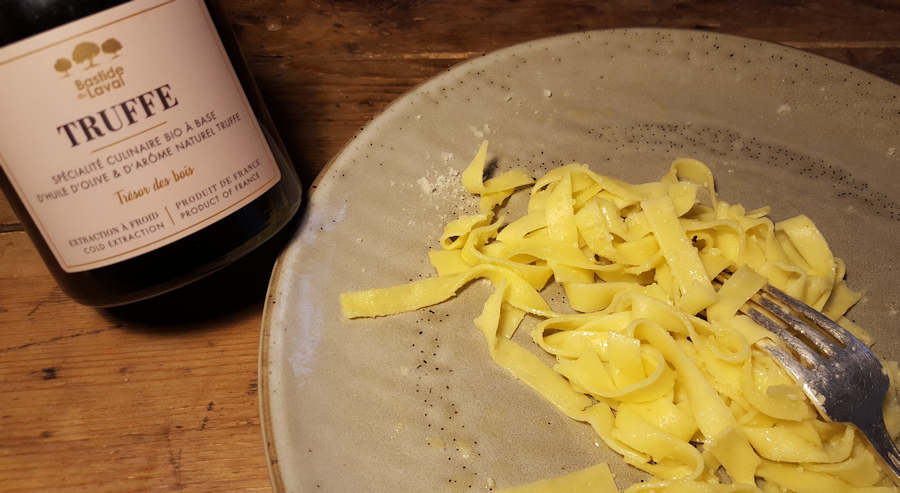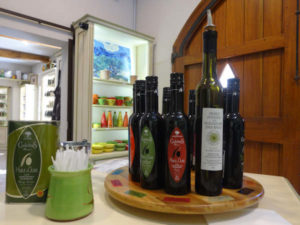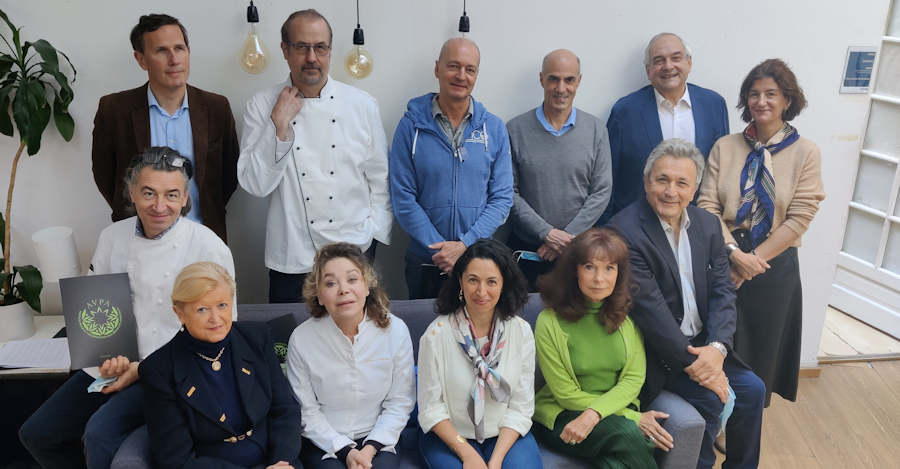
On the trails of an olive oil education, the author visits producers in the Luberon and near Les Baux, participates on the jury of an international competition, and adds some balsamic vinegar to this travel salad.
Somewhere along the way of my haphazard, improvisational French culinary education I got interested in olive oil—the diversity of olive oils—the different levels of greenness and maturity, olive varietals, oils produced after slight, controlled fermentation of the olives, and aromatic olive oils. It’s done wonders for my cooking; with few ingredients, I can enhance a salad, vegetable dish, fish or beef with a drizzle of this or a sprinkling of that.
I’m still an olive oil amateur, mind you, but I did get invited onto the jury of an international olive oil competition earlier this year. There were several juries, including a jury of olive oil professionals and juries of individuals experienced in tasting things. Mine was one of the latter. The challenge of being a juror isn’t to say I like this one or that one (anyone can do that) but to articulate your impression of each one, to compare judiciously and to defend your position, if necessary. I don’t know if I was up to the task, but I was certainly into the challenge. Here’s a picture of other members of the jury wondering what I’m doing there.

What was I doing there? I was using and improving my education in olive oil.
That was in Paris, but of course the most interesting way to educate one’s palate, improve one’s ability to articulate, and to meet producers and have fun along the way, is through travel, which for me means leaving Paris. Hitting the road and meeting people who know how to talk about what they produce or create—that’s the way I enjoy educating myself, and I take great pleasure in introducing travelers to those producers and creators.
Bastide du Laval in Cadenet (Luberon)
It was while biking in the Luberon area of Provence—lots of olive orchards in Provence—that I first stopped at Bastide du Laval. You don’t even have to be interested in olive oil to enjoy a walk among the orchards there with a beautiful view out to the Luberon hillscape.
In 1998, Roland and Carine Coupat, after living in the United States for a dozen years working in the tourist and travel industry, decided to return to France, and the following year they bought a wine estate in Cadenet in the Luberon area. While continuing to work in the travel business in France, they planted thousands of olive trees on the property. The trees grew and so did their son Léo. Léo now runs the place, which has about 4000 olive trees spread over 37 acres. Olive oil is the main product but there’s also still vineyard on the estate that produces some easy-drinking wine. Meet Léo.
Like most producers, Léo Coupat makes a wide range of olive oils. As I say, there’s a question of greenness, maturity, varietals, etc. Some of them are more to my taste than others—rather, some I would know how to use more than others. Visitors can have a free tasting of them all and also learn how olive oil is made. Any olive oil education should avoid the study of aromatics for the first semester, but here, on a second visit and with a little experience on my palate, I bought a bottle of Bastide du Laval olive oil with natural truffle aroma. I wanted to figure out how to use it without overpowering a dish. You know truffles, right?, truffe in French, those pungent tumor-shaped mushrooms that are dug up in, among other places, Provence. Call it truffle oil if you like, though that makes it sound as though the oil is from truffles whereas it’s produced by mixing truffle aroma in with the olive oil.
So what to do with this truffle oil? Léo advised me to start by drizzling a little on pasta to get a feel for how to use it. Start with some neutral extra virgin olive oil, he said, so that the fresh pasta won’t stick, then add just a bit of truffle oil, taste, then add more until you’ve found what you consider to be the appropriate dose. So that’s what I did, with a little salt and pepper, and topping my dish with parmigiano reggiano. Quite simple and quite good, I must say. My truffle oil education is now off and running.

So what do I try next? I’m thinking a slight drizzle on roasted or mashed potatoes, maybe grate some cheese on that. I’ll have to think about what cheese to use. If I were a French truffle hunter (or an expensive restaurant during truffle season), I’d add some bits of truffle in scrambled eggs for lunch or dinner, so I suppose that a nip of truffle oil instead of the actual truffles could work. Worth a try. But keep is simple, let the truffle oil do the work. You don’t need a dozen ingredients to make a pleasing meal. A sprinkling on grilled meat? Absolutely, with some herbs on top—herbes de Provence, of course. And pizza, I’ll definitely try it on pizza. How about on fish? Salmon? Maybe. Monkfish. Why not? But you’ve got to be delicate with aromatic olive oil, because as a wise man once wrote: “Just a little, not a lot, or something may happen, you never know…”
Bastide du Laval, 199 Chemin de la Royère, 84160 Cadenet. Tel.: +33 (0)4 90 08 95 80.
CastelaS in Les Baux de Provence
On another trip, driving this time—Saint Rémy, Les Baux, Arles—I had an enjoyable and instructive encounter with Catherine and Jean-Benoît Hugues, producers of CastelaS olive oil, at their mill, tasting room and boutique two miles east of the tourist village of Les Baux de Provence. Coincidentally, for I wasn’t actually looking for an American connection, they, too, had lived in the United States, 15 years in Arizona, before rerooting themselves in Provence in 1997.

Theirs is a tremendous estate, with 110 acres within the olive oil appellation (AOP or Protected Designation of Origin) Vallée des Baux de Provence and another 160 acres outside of the appellation zone. In the photo above, you can see the village of Les Baux in the background. From another angle, one would see the Alpilles in the distance. As at Bastide du Laval, you can enjoy a tasting of their wide range and also visit their installation to see how olive oil is made.

Returning recently, I bought a bottle of Noir d’Olive (Olive Black) oil, which has a deep, rich, slightly peppery, slightly fermented taste. “Perfect for salads, fish, mushrooms, mashed potatoes” reads the bottle, all of which sounds appropriate to me. I started with salad since it’s nearly a dressing in its own right. Next up, fish and mashed potatoes. The CastelaS website provides recipes for use of their olive oils.
Moulin CastelaS, Mas de l’Olivier, 13520 Les Baux de Provence. Tel. +33 (0)4 90 54 50 86. Taking D27 east of the village, you’ll see CastelaS on the left shortly before reaching D5.
Other Provence Olive Oils
Those are but two of the many olive oil producers in Provence. I discovered many other quality producers when the labels were revealed after my participation on the jury of the AVPA olive oil contest. AVPA stands for Agence pour la Valorisation des Produits Agricoles, meaning Agency for the Appreciation of Agricultural Products. Jean-Emmanuel Jourde, AVPA president, and Philippe Juglar, AVPA secretary, have created a judging system to award different types of edible oils (of which I was on one of the olive oil juries), coffees roasted at place of origin, teas of the world, and chocolates processed at place of origin.
(Several months after participating on the olive oil jury, I accepted an invitation to join on the jury for “fantasy” chocolates, which I found much more difficult as far as my own abilities to analyze, describe and rate. Along with notes of citrus, basil, cherry or whatever, I kept finding that the earthy dark chocolates tasted like delicious mud and had trouble finding other words for it without prompting.)

The olive oil competition was international, with most entrants naturally coming from Mediterranean countries, which produces the vast majority of the world’s olive oil. Spanish and Italian olive oils dominated among the winners. Lots of uninspiring industrial olive oils come from those world leaders in production, but we tasted some exceptional artisanal oils from there. French production, by comparison with other countries along the Mediterranean basin, is relatively confidential. Nevertheless, there were some Provençale stand-outs among the awardees, such Domaine Salvator (Cuvée Paradis), Huile H de Leos (Selection H de Leos Fruite Mur), Moulin à huile de Partegal (Cuve Magali), Moulin Cornille (Cuve 63), which can also be visited also near Les Baux de Provence, and “Lol’ive” Domaine Leydier (Noir cuve 9,2).
Balsamic Vinegar from Bals’Art in Roussillon
“French dressing” as known in the U.S. has little relation to the homemade dressing put on salad in French homes, which is typically a vinaigrette of olive oil, (wine) vinegar, (Dijon) mustard and seasoning. So after getting to know the olive oils of Bastide du Laval and Moulin CastelaS, I jumped on the occasion to get to know the balsamic vinegars of Jean-Michel Martias’s Bals’Art when I chanced upon his shop while visiting the pretty ochre-cliff village of Roussillon during a recent driving tour of the Luberon.
Jean-Michel Martias, who is originally from Marseille and has been producing vinegar since 2017, may have advisors and assistants, but to hear him speak about his balsamic vinegars is to hear the passion of a one-man band explaining how he arranges and plays his instruments. From my point of view as a vinegar novice, though a bit less so after visiting the shop, he presents a superb range of about two dozen vinegars. He also does perpetual research for future products. Most sales are from his shop in Roussillon, where visitors can have an extensive tasting, and online.

Jean-Michel currently produces his vinegars from the musts of organic syrah and granache grapes from Provence and Lambrusco (red) and trebbiana (white) from Italy. He uses low-temperature reduction over 10 to 40 hours, so while his balsamic vinegars don’t follow the process (and pricing) of 12+ years of wooden-barrel ageing that goes into Traditional Balsamic Vinegar of Modena, they are also a far cry from the watered down industrial balsamic vinegars that are typically found in supermarkets. For his flavored vinegars, the flavor comes through maceration of, for example, basil, pepper, lemon or lavender honey.
I purchased a bottle of his Velours Noir (Black Velvet), a dense, syrupy vinegar tasting of ripe cherry and raspberry. Too rich and intense for a vinaigrette, I think. When I called Jean-Michel later from home to ask how else he recommended that I use it, he suggested dribbling it on a tomato or sprinkling it on vanilla ice cream or drizzling some on duck magret. For now, I’ve only enjoyed a few drops on a teaspoon, then a few more drops, and I had to stop myself before consuming the entire bottle as though it were an after-dinner liqueur.
I also bought a balsamic vinegar block, a product that Jean-Michel makes by adding to his vinegar the gelling agent agar-agar, an extract from red seaweed from along France’s Atlantic coast. Using a fine grater, I grated a few bits on an endive salad on which I’d simply poured some of the CastelaS Noir d’Olive mentioned earlier. It tasted as I would have imagined: vinegar strips in an olive-rich salad. Interesting, I’d say for now. Again, I asked Jean-Michel how best to approach the block. Use it wherever you might otherwise add a squeeze of lemon or a drizzle of balsamic vinegar, he told me. In other words, it’s something to play with during recess while pursuing my Provence olive oil education.
Bals’Art, 15 rue du Castrum, 84220 Roussillon. Tel.: +33(0)4 32 52 16 40.
© 2021, Gary Lee Kraut

